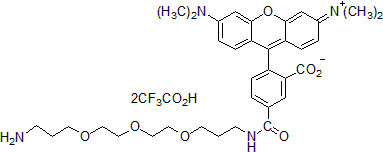TAMRA-PEO3-amine, TFA salt, 5 isomer
5-TAMRA-PEO3-amine (Tetramethylrhodamine-PEO3-amine) has a long water-soluble PEG spacer separating the dye and the amine functional group. The dye can be coupled to activated carboxy groups or sulfonyl chlorides.
This product is available by special order only.
Please fill in the inquiry form and we will contact you shortly.
Please fill in the inquiry form and we will contact you shortly.
Wishlist updated! View wishlist
Product Description
5-TAMRA-PEO3-amine (Tetramethylrhodamine-PEO3-amine) has a long water-soluble PEG spacer separating the dye and the amine functional group. The dye can be coupled to activated carboxy groups or sulfonyl chlorides.
- λEx/λEm (MeOH) = 544/571 nm
- Dark purple solid soluble in DMSO, DMF, or H2O
- Store desiccated at 4°C and protect from light
- C39H46F6N4O11
- MW: 860.74
You may also like…
CF® Dye Amine
CF® Dyes with a reactive amine group to fluorescently label carboxylic acid groups in proteins and other molecules.
DMSO, Anhydrous
Anhydrous DMSO (dimethyl sulfoxide; methyl sulfoxide) is recommended for preparing stock solutions of AM ester dyes, reactive dyes and other related moisture-sensitive products.
CF® Dye & Biotin SE Protein Labeling Kits
Kits for succinimidyl ester labeling antibodies or other proteins with Biotium's next-generation CF® dyes or biotin. 3 x 1 mg labeling reactions per kit.
CF® Dye Aminooxy
CF® dyes with an aminooxy reactive group are useful for fluorescently labeling aldehyde or ketone groups on target molecules such as polysaccharides, glycoproteins or antibodies.
CF® Dye SE/TFP Ester
CF® Dye SE/TFP esters are amine-reactive fluorescent dyes. They are commonly used to label primary amines of antibodies and other proteins, amine-modified oligonucleotides and other amine-containing molecules.
EDC (EDAC)
EDC (or EDAC) (1-(3-Dimethylaminopropyl-3-ethylcarbodiimide, hydrochloride)) has recently been found to be very useful for fixing in situ chelators, including the fluorescent ion indicators for histological studies following physiological experiments. EDC is also a widely used reagent to activate carboxy groups for amine coupling.

